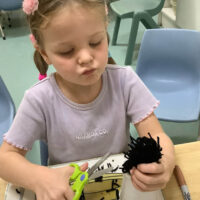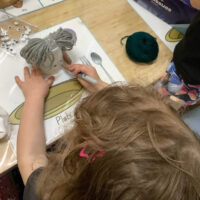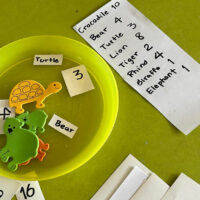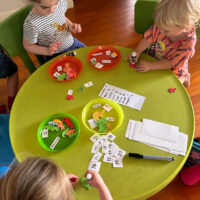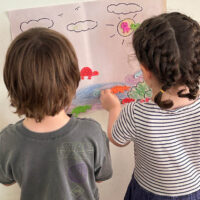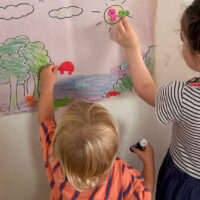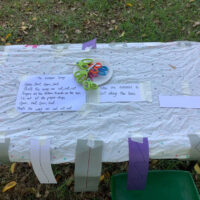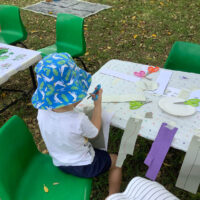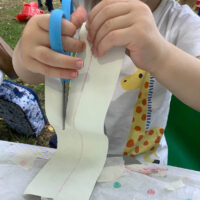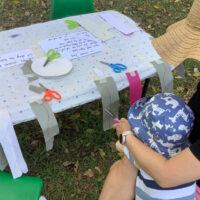Johnson House
Waratah Room
Story by Educator Sanju
The children in Johnson House’s Waratah room have been enjoying dramatic ‘hair salon’ play. To further scaffold this interest, the children were encouraged to make their own dolls, using paper cups and wool for the dolls’ hair, and they were given the opportunity to practice their hair styling and cutting skills with the dolls.
The children started the experience by making some ‘paper cup buddies’ and using different coloured yarn for the hair. The children chose the coloured yarn they wanted to use, and they discussed how we all have different coloured hair. Once the children had finished making the dolls, they added googly eyes using glue and created faces using markers. Finally, it was time to practice their scissor skills, and to give their little buddies a haircut!
The children enjoyed cutting the dolls’ hair, and realised it needs lots of practice to master the skill of hairstyling. The children shared their knowledge that hairdressers must do lots of training to get to work in a hair salon. The children showed great attention to detail while winding the yarn and holding the little googly eyes to apply glue to them before sticking them to the cup. It was lovely to see their teamwork and cooperation as they helped each other by suggesting different hair styles. Everyone was keen to share their experiences as they practiced their skills with scissors. It was also a great way to discuss the similarities and differences amongst us all.
Family Day Care Sydney Wide
Story by Educator Support Officer Alix
It’s always exciting to observe how educators within a Family Day Care context are so attuned to differentiating learning experiences to suit mixed aged groupings of children.
During my most recent visit to Rose’s Family Day Care in Willoughby, Rose had planned a combined literacy, numeracy, fine motor and imaginative play experience which allowed children of various ages and abilities to participate in whatever way they desired.
For the older children of the group, the objective was to model and encourage identifying, categorising and counting scattered pictures of different animals. To enhance literacy and numerical symbol learning, Rose had animal name labels and numbers prepared to correspond with each animal’s grouping. The children could then paste the animals of their choosing onto a pre-drawn nature landscape, which was mounted to the wall. This experience allowed for lots of collaboration and peer scaffolding, as the older children modelled their language, animal knowledge, counting skills and imaginative play ideas to the younger children. This experience was such a beautiful example of inclusive practice and the fostering of positive relationships between the children.
Community Playgroups
Story by Playgroup Coordinator Rebecca
This week at playgroup we began to focus on our scissor skills. Allowing children to use scissors can be a big step for both parents and children. Parents often worry that their child may hurt themselves while learning to use scissors and for children, using scissors comes with guidelines that need to be followed, for safety. Knowing where to place their fingers on a pair of scissors and working out how to manipulate them correctly can be difficult for children, especially at first. At playgroup we encourage the children to hold scissors the correct way by singing this song:
Open, shut, open, shut,
That’s the way we cut, cut, cut.
Fingers on the bottom,
Thumbs on the top,
Don’t let the paper drop!
Open, shut, open, shut,
That’s the way we cut, cut, cut.
Being able to cut with scissors is an invaluable skill. Learning to use scissors helps to strengthen children’s hand and finger muscles and teaches them how to move their fingers independently of each other. This ability is important for everyday activities such as drawing, getting dressed and using cutlery.
Cutting with scissors helps children to learn to use both sides of their body, as they need to use one hand to manipulate the scissors and the other hand to hold the paper. This is called bilateral coordination and helps with any activity that requires you to use both sides of your body in different ways at the same time.
Using scissors also requires an enormous amount of concentration by a child, helping to improve their attention span which is important for being able listen and learn in other contexts.
Allowing children to use child-safe scissors with a variety of things to cut such as paper, leaves, wool and playdough helps children to develop valuable skills for the future.
